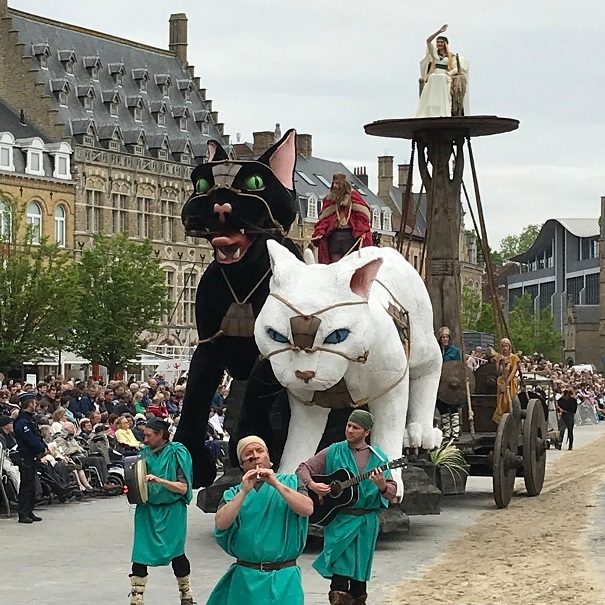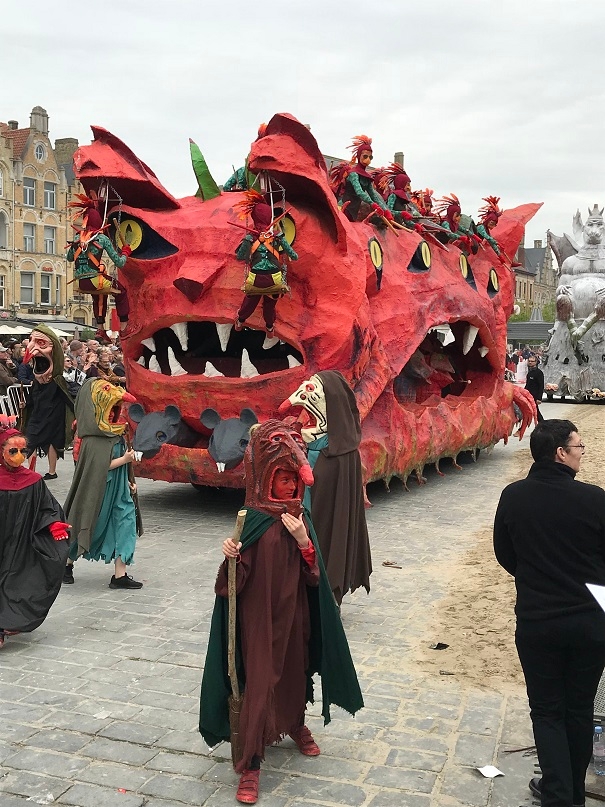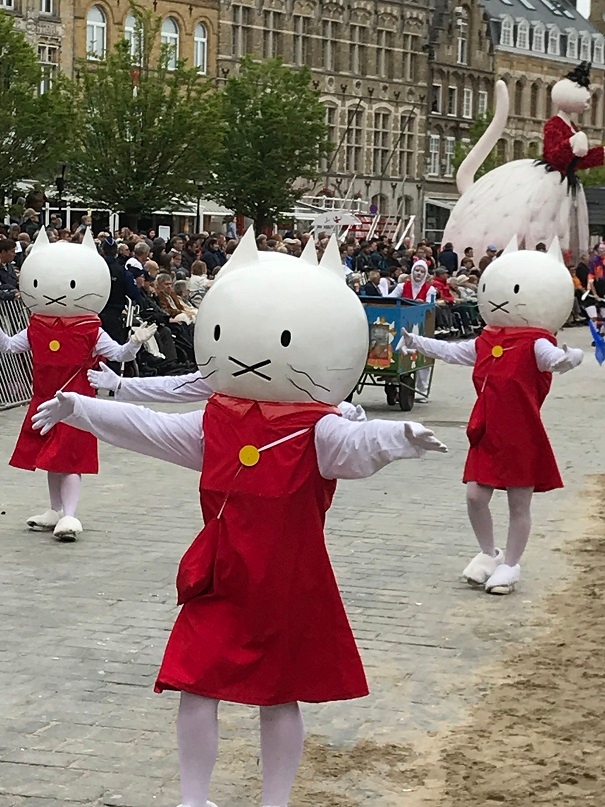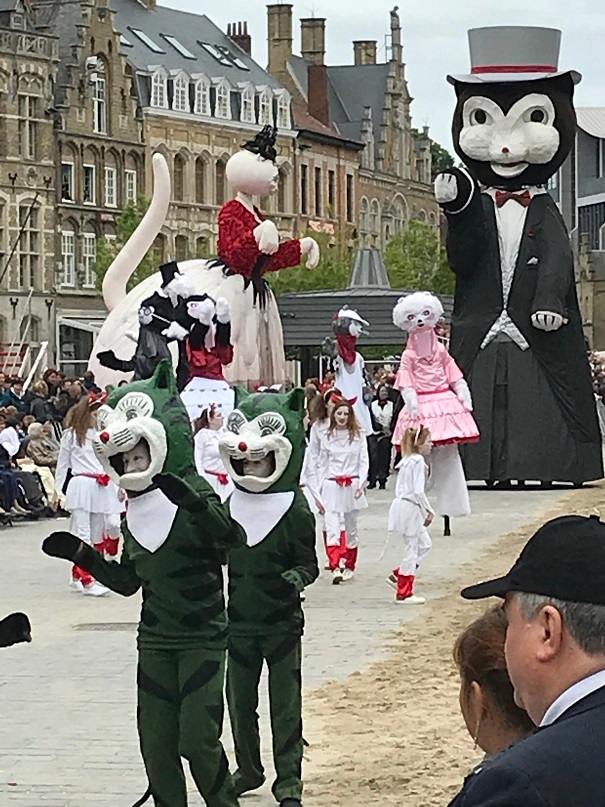Ypres Cats Festival (No. 7)
 When spring arrives in Belgium, traditional festivals are being held in every region. One of those festivals is the Cats Festival, held once every three years in Ypres, a city located in the province of West Flanders. The year 2018 coincides with the organizing of the festival, and on the second Sunday of May, on the 13th, the Cats Festival was held, crowded with many visitors. When spring arrives in Belgium, traditional festivals are being held in every region. One of those festivals is the Cats Festival, held once every three years in Ypres, a city located in the province of West Flanders. The year 2018 coincides with the organizing of the festival, and on the second Sunday of May, on the 13th, the Cats Festival was held, crowded with many visitors.
Ypres, a city located almost in the middle of the Flemish plains, has flourished since the Middle Ages as a production center for woolen fabrics. The Cloth Hall and the St Martin's Cathedral across the “Grote Markt” (market square) in the city center are both stately Gothic buildings built in the 13th century, surpassing in scale the historic buildings in other regions of Belgium. However, because of its unfortunate strategic location, Ypres suffered from the damage of wars, such as the Hundred Years’ War between England and France and the foreign invasion by Louis XIV of France. Especially when we get to the 20th century, it became one of the most severe battlegrounds of World War I, resulting in almost complete destruction and many victims. The Cats Festival as we can see it today is also said to have started out as a commemoration for the reconstruction of the city in 1938, 20 years after the end of the war.
 From 8:00 pm onwards on Saturday 12th May, the night before the festival, dance and music performances related to cats were staged throughout the city, creating an exciting atmosphere. From 8:00 pm onwards on Saturday 12th May, the night before the festival, dance and music performances related to cats were staged throughout the city, creating an exciting atmosphere.
The highlight of the festival is definitely the Cats Parade that takes place around 3:00 pm on the Grote Markt. There is actually no equivalent for what we call in Japanese "neko matsuri" (cats festival), as in Ypres the whole festival is simply referred to as the "Kattenstoet (Cats Parade)", from which you can understand the importance of the parade.
In the parade, there were many different kinds of performances related to cats, all pleasing to the eyes of the spectators. There was a parade of children dressed up like mice and cats, another one with cats, witches and demons, a parade with cats from all over the world including Garfield, Hello Kitty and cats from the musical “Cats”, as well as a parade with Minneke Poes, a huge cat figure who symbolizes the festival, together with her family.
The evening following the end of the parade, plush toy cats are thrown towards the crowd off the balcony of the Cloth Hall’s belfry in the middle of the Grote Markt. Legend says that good luck will come to whoever is successful at catching one. After the throwing of the cats, there was a scramble to catch one, and together with excitement, cheers and sighs, the end of the festival drew near.
 The Cats Festival of Ypres has become well known in Japan as well, mainly among cat lovers, and this time too, many Japanese came to see it. Although it is unknown exactly how many Japanese people attended, it is my estimate after a brief look at the audience that approximately one in ten persons were Japanese. The majority of the spectators were from Belgium or neighboring European countries such as France, the Netherlands and the UK, and therefore I felt strongly about the Japanese presence. Among the Japanese cat lovers, some people stood out, having cat makeups or wearing cat costumes while everyone else was dressed plainly. The Cats Festival of Ypres has become well known in Japan as well, mainly among cat lovers, and this time too, many Japanese came to see it. Although it is unknown exactly how many Japanese people attended, it is my estimate after a brief look at the audience that approximately one in ten persons were Japanese. The majority of the spectators were from Belgium or neighboring European countries such as France, the Netherlands and the UK, and therefore I felt strongly about the Japanese presence. Among the Japanese cat lovers, some people stood out, having cat makeups or wearing cat costumes while everyone else was dressed plainly.
Japanese cat enthusiasts may be disappointed but I came to understand that the Cat Festival of Ypres is not necessarily just an opportunity to express love and affection for cats.
I heard from Mayor of Ypres Mr. Jan Durnez that the origin of this festival can be found in the cat throwing from the Cloth Hall’s belfry. Of course animal cruelty is forbidden nowadays, but documentary evidence exists that until 1817, real cats instead of stuffed ones were thrown.
From what was featured at the parade, the relationship between cats, witches and witchcraft was apparent. It is written in many sources that in Europe, from the Middle Ages until the modern era, cats were regarded as a witch or a devil’s helper, closely related to evil spirits. It is said that rituals to exorcise evil spirits by killing cats have been widely observed in Europe from the pre-Christian era up to the modern age.
I remember there is a short story from the first half of the 20th century called "Ancient Sorceries", written by the great British horror novelist Algernon Blackwood, about a hero who travels in the French countryside and unknowingly turns into a cat and gets caught up in a medieval witch trial. It seems that the fear and negative feelings held by European people towards cats became the theme of this novel.
 There is of course no doubt that people also have love and positive feelings for cats. There is of course no doubt that people also have love and positive feelings for cats.
In pre-modern Europe, where the hygiene conditions we know today could not be guaranteed, cities constantly faced crises of infectious diseases. The carriers of these infectious diseases are mainly rats. As cats were saving the citizens from crises of infectious diseases by catching rats, they might have been regarded as valuable.
Being a production center for woolen cloth, Ypres has a history of prosperity since the Middle Ages, but when it comes to the preservation of wool, the rat is a natural enemy. It is said that a large number of cats were kept in Ypres’ Cloth Hall in order to exterminate the rats and safely preserve the cloth.
In this way, the complex feelings that Europeans have towards cats seem to appear in Ypres ' cat festival.
The next Ypres Cats Festival will be held three years from now, on the second Sunday of May 2021, that is to say on May 9.
I very much hope that Japanese people, cat lovers and others alike, come to the festival in great numbers and experience it firsthand.
|

